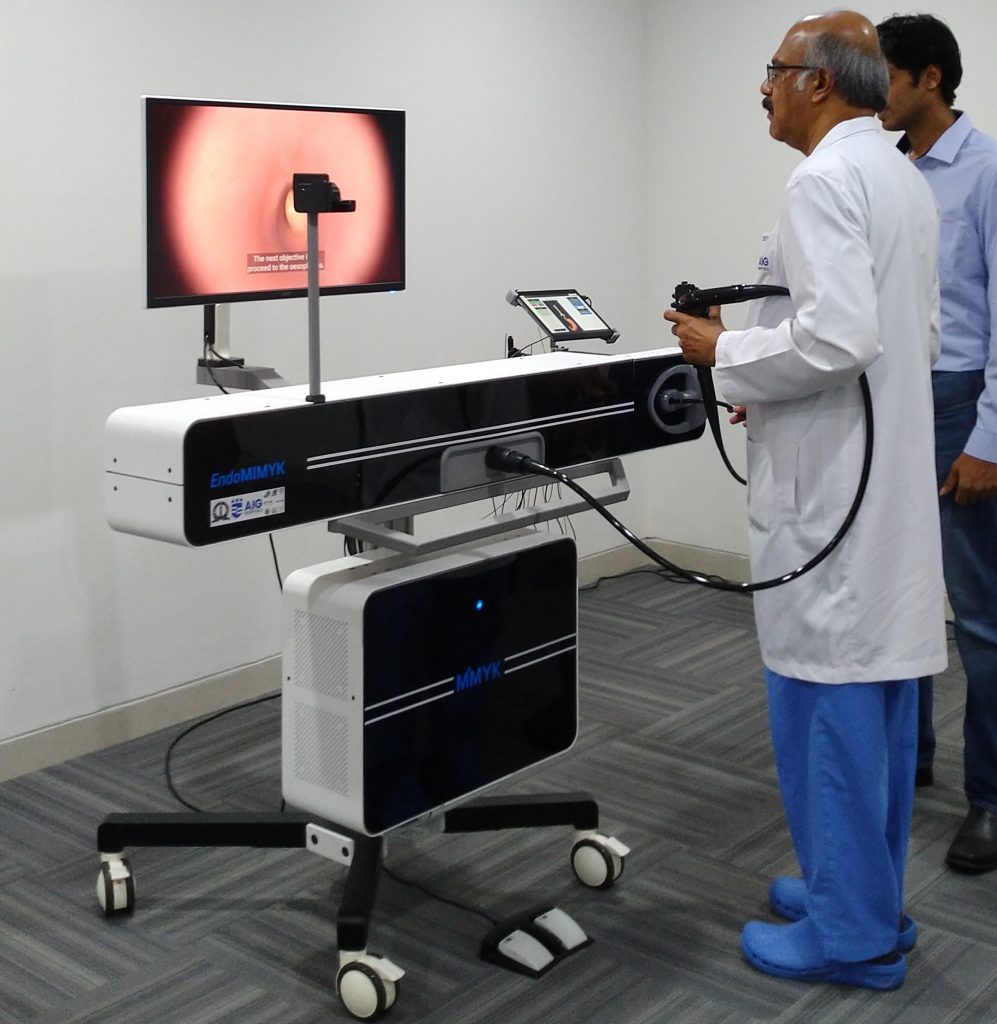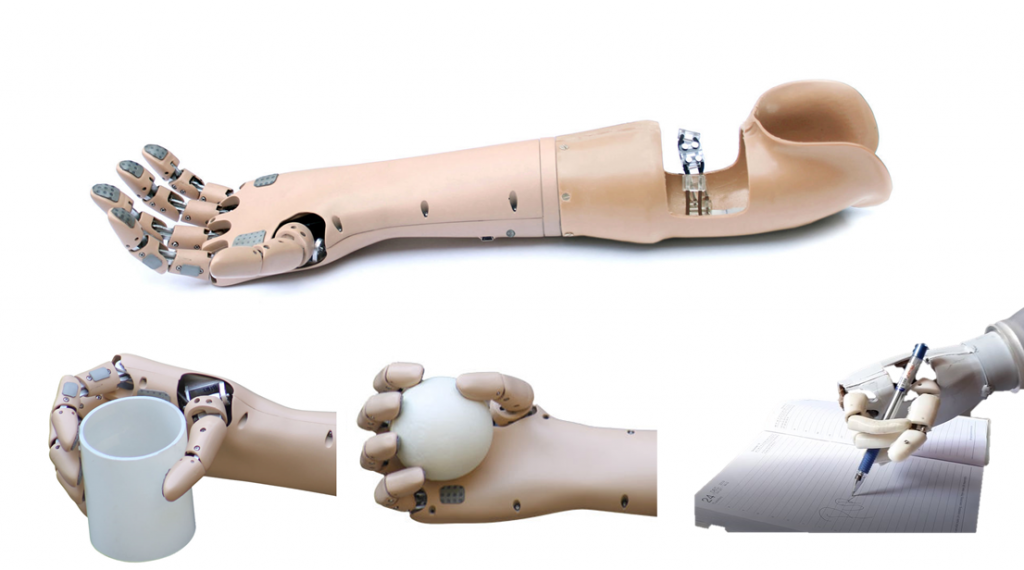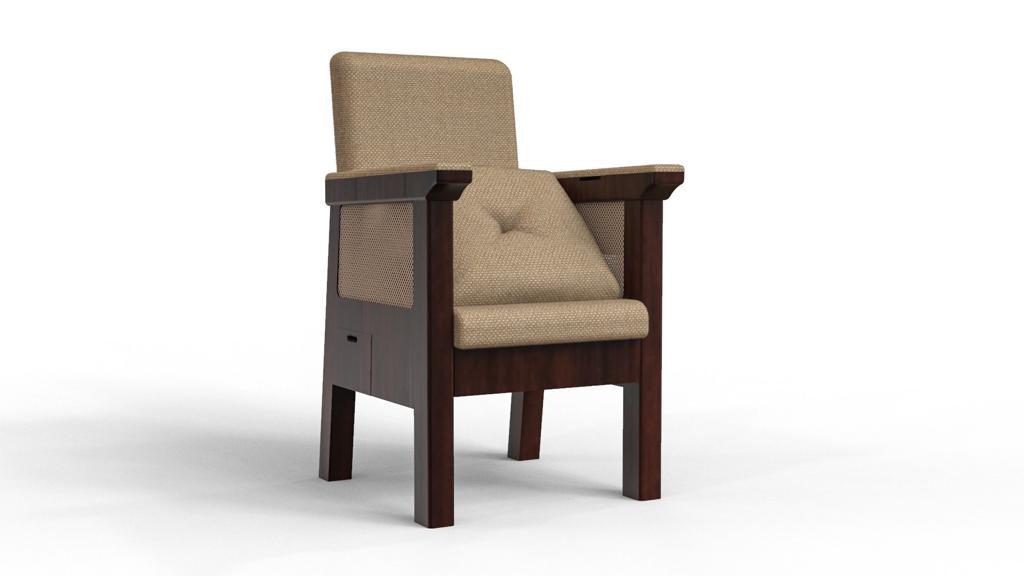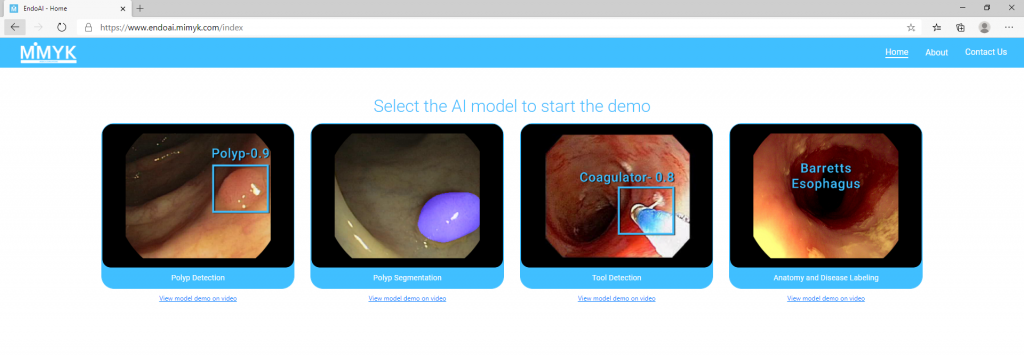They offer a range of products from those that train doctors and improve medical procedures to ones that help vulnerable groups live more independently

In 2011, Vinay V and Nilesh Walke were classmates pursuing a Master’s degree at IISc’s Centre for Product Design and Manufacturing (CPDM). They knew a member of their department workshop, who was an amputee, but who did not use any prosthetic device in place of the lost limb. On speaking to him about it, they found out that the prosthetic arms available in the Indian market did not suit his needs – they were either too heavy and not functional enough, or were far too expensive. That got them thinking. After conducting surveys among upper limb amputees across the country, they found this to be a common problem – and wondered if it was one they could solve.
As a part of their Master’s thesis, under the guidance of Dibakar Sen, a Professor at CPDM, they developed a proof of concept of a terminal prosthetic device for upper limb amputees. It was further developed through a Wellcome Trust research grant and tested with 50 users across the country. In 2019, they went on to launch Grasp Bionics, a startup to produce bionic devices.
Devices like theirs are part of the rapidly growing medical devices industry, which has been recognised as a ‘sunshine industry’ by the Indian government’s Make in India campaign to encourage its growth. In 2017, industry estimates claimed that the Indian medical device market would grow to Rs 53,053 crore in 2020. The National Health Policy of India (2017) further acknowledges the need to promote indigenous medical technology innovations and to make healthcare accessible to the general public.
Grasp Bionics is one of many medical technology start-ups incubated at IISc that focus on various aspects of healthcare and on bridging the gaps in it. Like Maitra Medtech, Mimyk Medical Simulations and Neu Integrals, it is one of the newer companies incubated at the Institute that aim to bring innovative and affordable medical technology to the doorsteps of the country’s large population.
Seizing opportunity
Grasp Bionics focuses on amputees, who may have lost their limb(s) due to trauma, disease or infection. Amputees are said to constitute a considerable proportion of the people in India with motor disabilities, though the exact number is not known. There is a variety of prosthetic devices in the market targeted at amputees, however, these devices fall on a wide spectrum in terms of functionality and cost.
“The low-priced prosthetic arms are not battery powered, which means the user needs to use their other arm or shoulder movements to open and close the hand. On the other hand, completely functional arms with motors powering all five fingers are usually imported and priced much higher,” says Vinay.
Their prosthetic arm, named Purak – which Vinay describes as ‘completion’ or complementing the body – uses the mechanical expansion of the muscles as a signal to operate Purak, making it intuitively controllable, even if the user’s arm is sweaty. “It also adapts to the shape of the object and allows the user to apply variable force on the object,” he explains. Made from a combination of lightweight metal and polymer, it weighs around 320 grams and is priced 10 to 15 times lower than its imported counterparts, which could cost over Rs 20 lakh.

The prosthetic arm, Purak, and the variety of grips it provides to users
(Photos courtesy: Grasp Bionics)
Grasp Bionics also aims to help build a clear path towards rehabilitation of amputees after surgery. While sophisticated amputation techniques exist in India, the rehabilitation service after amputation is often lacking due to the low number of rehabilitation centres and trained prosthetists.
“Hospitals are often involved only till the amputation stage, following which the patient does not have a clear-cut roadmap guiding them in how to proceed – be it the appropriate type of prosthetics, whom to approach for rehabilitation or the rehabilitation process itself,” Vinay elaborates. Their team plans to coordinate between hospitals and a network of rehabilitation centres in different regions of the country, to get information about people who undergo amputation. They would like to be involved in counseling the patient in their journey, right from amputation to choosing the right prosthetic device for themselves.
A focus on the elderly
Another start-up that aims to equip people to live independently is Maitra Medtech, which seeks to focus on the overall quality of life of senior citizens (who form 8.6 percent of the country’s population, according to the 2011 Census). The company, founded by biomedical engineer Leena Kunnath and medical doctor Kiran Warrier, has developed a low-cost eye drop dispenser for glaucoma medication. Kunath and Warrier were winners of the ReImagine Health Hackathon 2019, hosted by CPDM’s MedTech and Geriatric Healthcare Technology Business Incubator.
Glaucoma is a group of conditions leading to the damage of the optic nerve, and can further lead to blindness if unchecked. The National Health Portal of India estimates that this disease affects at least 12 million people in India. The first line of treatment is usually through eye drop medication. However, using these eye drops could pose a problem to those who do not have assistance to do so. Dr. Parikshit Gogate, a Pune-based ophthalmologist, elaborates, “Glaucoma affects a large number of senior citizens, and causes the visual field to be constricted. Additionally, if their hand-eye coordination is poor due to age or disorders like Parkinson’s, they might find it difficult to put the drops into their eyes themselves.” Using wrong quantities of these eye drops or adding them improperly can prove costly to the patient, both in terms of health and money.
Maitra’s device works by allowing the patient to fit their prescribed eye drop bottle into it. The device can then be easily and accurately positioned over the eyeball in a steady position
One solution to this problem could be the cost-effective eye drop dispenser created by Maitra Medtech, an idea that Kunnath says was welcomed when they pitched the concept of the product to several old age homes and doctors. Maitra’s device works by allowing the patient to fit their prescribed eye drop bottle into it. The device can then be easily and accurately positioned over the eyeball in a steady position, and the patient merely has to press the device for the correct amount of eyedrops to be added into the eye. “We have also added an electrical component through which the data of the patient’s usage gets collected in a server, which can be used by the doctor. This would also be helpful to doctors in prescribing further medication,” says Kunnath.
Building their device wasn’t an easy task: Kunnath recounts that when they initially outsourced the designing, the design did not match their vision. In order to create a satisfactory design, she learned how to design the product herself, despite the time and effort involved. Maitra also worked with a team of doctors to design this sensitive and precise dispenser.
Like Maitra, another product by a start-up incubated at IISc named Neu Integrals Medtech Pvt Ltd aims to address issues facing the elderly. A common condition in the elderly is knee problems due to a variety of age-related issues including osteoarthritis (which affects 28.7 percent of people in India). People with joint problems often face difficulty while sitting down or rising from a chair, due to the pressure on the affected regions. Manoj Kumar R, the company’s Director, gives the example of other tasks like visiting public places which lack seating arrangements dedicated to senior citizens. Difficulties in sitting and rising easily could mean that they end up standing or avoiding the task altogether.
To this effect, an assistive chair for the elderly was conceptualised and created by GK Ananthasuresh – Professor in the Department of Mechanical Engineering – in his Multidisciplinary and Multiscale Design and Device (M2D2) lab, and commercialised by Neu Integrals. The chair, named Stand at Ease, offers the user physical support while sitting or rising from it, by using a hinge mechanism. This product can help enhance the quality of daily life of people with knee problems and give them the independence that they desire.

The elderly assistive chair developed at the M2D2 Lab
(Photo courtesy: M2D2 Lab)
Kumar, who was previously a Project Assistant in Ananthasuresh’s M2D2 lab, draws attention to the fact that such a product has not been widely available in India. He also says that they aim to provide these chairs to individuals as well as places that receive visits from the public to make them accessible to the elderly. He adds, “This technology is also simple, making it easily operable and reducing manufacturing costs to make it affordable to senior citizens.”
Widening the scope of medical training
While Grasp Bionics, Maitra Medtech and Neu Integrals focus directly on products for vulnerable populations, one company incubated at IISc works on tools to train and assist healthcare professionals. Mimyk Medical Simulations works in the relatively niche field of endoscopy procedures and training, which are usually performed by specialists in the field.
Endoscopy is a non-surgical investigative procedure during which a long, flexible tube with a camera at its end is inserted into the body through openings like the mouth or nose to visualise regions of the body. This could be used to examine the gastrointestinal tract, reproductive tracts and other internal organs. It is commonly used to diagnose and treat problems like ulcers, tumours and bleeding in the digestive tract.
Mimyk, in collaboration with Asian Institute of Gastroenterology (AIG) and experts in the field such as Dr Nageshwar Reddy (Chair, AIG) and Dr K Lakshman (Shanthi Hospital and Research Centre), has developed a novel endoscopy simulator, EndoMimyk, to help train medical students and professionals to perform this procedure.
Mimyk has developed a novel endoscopy simulator, EndoMimyk, to help train medical students and professionals to perform this procedure.
The simulator was conceptualised and initially developed during co-founder Shanthanu Chakravarthy’s PhD research at Ananthasuresh’s lab at the Department of Mechanical Engineering. This work was part of a larger interdisciplinary research project led by Ananthasuresh and Vijay Natarajan, Professor at the Department of Computer Science and Automation (CSA), IISc and was supported by the Robert Bosch Centre for Cyber Physical Systems on the campus. Mimyk was started and incubated at the Society for Innovation and Development (SID), IISc.
Raghu Menon, co-founder of Mimyk, who previously completed his MDes degree at CPDM, IISc, points out the high cost of the endoscopy set up and maintenance, which makes having an endoscopy unit, and consequently training, less accessible. Independent experts like Dr Puneet Dhar, Professor and Head of Surgical Gastroenterology at AIIMS Rishikesh, also highlight that often, the patient load is either so high that trainees are unable to devote time to perform endoscopies, or too low for proper training to take place. An endoscopy simulator is of immense value in such a situation, to train students without requiring real patients.
“Unlike physical simulators which use dummies, our simulator has two main features – the haptic (touch based) system and physics-based interactive models, which provide an immersive, real-time experience of the procedure through touch as well as visuals,” says Chakravarthy. Through this technology, the user can experience force, resistance and other properties that they would encounter in a real situation. Menon adds, “Virtual Reality and haptic robotics can be used to bring in an element of reality to simulate different pathologies and case studies, like tumours and emergency bleeding. Training for such situations on real patients would be very difficult.”
Taking this beyond training, they have developed tools using machine learning and artificial intelligence (AI) to assist specialists during the actual endoscopy process as well. Nithin Shivashankar, also a co-founder of Mimyk, who completed his PhD from CSA, leads the technology charge. They have developed an app that could help clinicians identify and categorise abnormalities and the regions of the body where the scope travels. Their AI-driven tools could help clinicians to make rapid decisions in real time if they find abnormalities that need immediate attention.

In addition to its novelty, the simulator is more affordable than imported simulators, as this indigenous technology has been developed at IISc itself. Other than a few imported components, local manufacturing is possible, which further reduces the cost of the product. While other endoscopy simulators developed outside India have a set of simulations with more number of different types of case studies, EndoMimyk’s makers say that it brings sophisticated technology to the table.
Mimyk plans to develop their machine learning algorithms and smart tools to help in the actual endoscopy procedures. Ananthasuresh also adds that in the future, this simulation technology coupled with assistive robotics systems could be expanded to allow clinicians to perform endoscopy procedures from afar.
While endoscopies are routine procedures in countries with more developed healthcare facilities, they aren’t in India, and with more accessible training in India and assistive tools, such non-surgical procedures can be used more frequently for efficient, precise and accessible diagnostics and therapeutics.
Anoushka Dasgupta is a Master’s student in Biotechnology from Institute of Bioinformatics and Biotechnology, Pune University. She is interested in science writing.
To read more articles in this series about start-ups incubated at IISc, click on the links below:
Building Intelligent Technology




